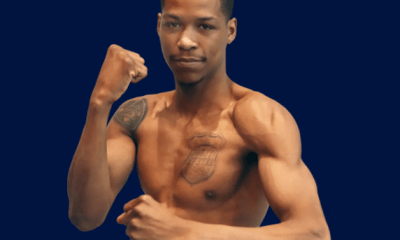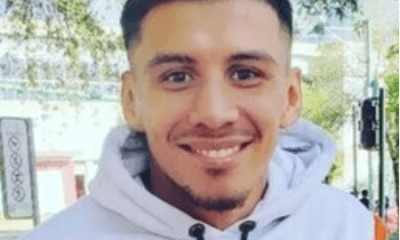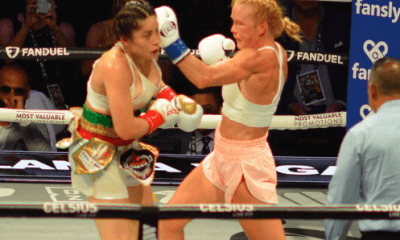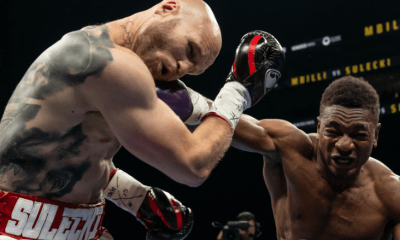Featured Articles
The Hauser Report: Dmitry Bivol, Canelo Alvarez, and DAZN
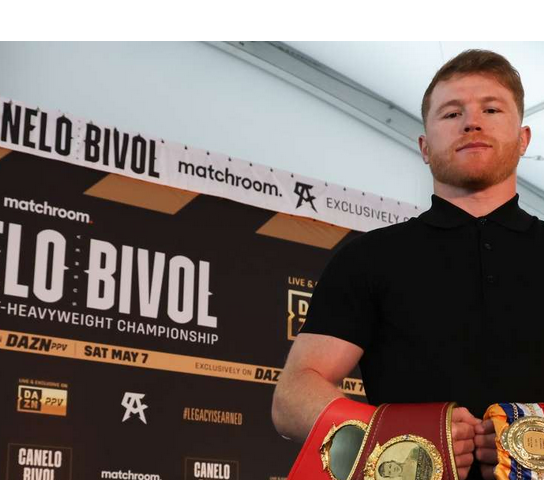
On May 7, Rich Strike, an 80-to-1 longshot, turned thoroughbred horse racing upside down by winning the Kentucky Derby. That night, Dmitry Bivol scored an upset of even greater consequence when he outboxed Canelo Alvarez at T-Mobile Arena in Las Vegas to earn a unanimous decision over boxing’s reigning pound-for-pound king.
Alvarez (now 57-2-2, 39 KOs) is 31 years old. In recent years, he has been boxing’s premier fighter, a magnet for high-rollers, and a massive pay-per-view draw. As Paul Magno recently wrote, “He has become the best in the world in a very old school way – by developing his game in the gym and adding respectable names to his resume.”
At the start of this year, Canelo was also a promotional and network free agent. He’d fought six consecutive fights on DAZN with Golden Boy or Matchroom as his promoter and then jumped ship to fight Caleb Plant on Showtime-PPV under the Premier Boxing Champions banner. His victory over Plant was followed by spirited bidding for his services. PBC hoped to match Canelo against Jermall Charlo. Matchroom Boxing CEO Eddie Hearn was pushing Bivol as the opponent.
In late-January, Eddy Reynoso (Canelo’s trainer) opined, “I think a Charlo fight is more media-friendly. Charlo is a fighter that sells more, a fighter that more people follow. And because of that, it’s a more attractive fight.”
And also a less dangerous fight.
But DAZN was anxious to get back in the Canelo business. And Len Blavatnik (the Ukrainian-born, multi-billionaire whose exceedingly deep pockets finance DAZN) took an interest in Canelo. The two had lunch together in Miami last year the day after Canelo beat Avni Yildirim.
Also, on February 11, Charlo was arrested on a charge of felony assault (later dismissed) in Texas. That added an element of uncertainty to any Canelo-Charlo venture.
On February 26, it was announced that Canelo had signed a two-fight deal with Matchroom and DAZN. The first fight would be in Las Vegas for Bivol’s WBA 175-pound belt in conjunction with Cinco de Mayo weekend. The second was provisionally scheduled for September 17 in conjunction with Mexican Independence Day weekend against Gennady Golovkin at a site to be determined. Canelo’s minimum purse for fighting Bivol was reported as $40 million with a $60 million payday should he fight Golovkin in September. The contract was said to include an option in Matchroom’s favor for a third fight against an unspecified opponent and an option for a rematch in Canelo’s favor should he (ha ha; no way it will happen) lose to Bivol.
Bivol (now 20-0, 11 KOs) is five months younger than Canelo. He won the WBA 175-pound title in 2017 by knocking out the undistinguished Trent Broadhurst and had defended his belt seven times against largely pedestrian opposition. His previous six opponents had gone the distance against him.
After Canelo’s choice of opponent was announced, there was some sniping that, in fourteen fights dating back to 2015, he’d faced only one Black opponent (Danny Jacobs). Charlo and Spence would have run counter to that trend.
Canelo-Bivol was Canelo’s fifteenth fight in Las Vegas, where he has taken part in three of the five highest-grossing gates in state history. Alvarez was a 9-to-2 betting favorite. Those odds seemed long. Sergey Kovalev’s reach and jab had given Canelo trouble when they fought in 2019. Bivol has a better jab than Kovalev and his footwork is far superior to Sergey’s. Most likely, Dmitry would have been favored over all of Canelo’s previous opponents with the possible exception of Golovkin.
“He has good power,” Bivol said of Canelo. “He has good skills. First of all, he’s a good fighter. But he’s a man and he had a loss and draw. If you believe in your skills, if you’re a good boxer, you could make him one more loss. I have enough to win this fight.”
“I chose Bivol because he’s a great fighter,” Canelo said in response. “He’s a fighter who fights at distance, good distance. He moves; he’s fast for the division; he’s strong. He’s, for me, the best fighter at 175. I saw him many times. He knows what to do in the ring. He’s a champion for a long time. I know what kind of fighter he is but I don’t care. I’m in my prime and I have a lot of skills. I want to make history in my career and I’m gonna continue doing it with this guy.”
*
I didn’t watch Canelo-Bivol live on Saturday night. That might sound odd for a writer who would be writing about the fight. But it was a matter of principle.
I admire Canelo Alvarez as a fighter and a person. I’ve been in his dressing room in the hours before and after five of his biggest fights and hope to be there again in the future. But Bivol (who was born in Kyrgyzstan) is a Russian citizen and has lived in Russia since age eleven. I agree with Vitali and Wladimir Klitschko who voiced the view that, given Russia’s brutal aggression in Ukraine, Bivol shouldn’t have been chosen to fight Canelo. That, to me, would have been an appropriate extension of the economic sanctions currently in place against Russia.
DAZN and Matchroom took a contrary view. So did the world sanctioning organizations. On March 28, the WBA announced that it would sanction Canelo-Bivol for its 175-pound title (and the lucrative sanctioning fee that accompanied its sanction).
Two days later, after a trip to the Middle East that saw him wholeheartedly endorse Daniel Kinahan’s involvement in boxing, WBC president Mauricio Sulaiman declared, “I’m glad that this fight is taking place and when they are in that ring, they can show that boxing is far above politics. It is a sensitive issue because of what is happening, but we have also said that the boxers are not to blame for anything. I am happy that this fight is taking place. It has nothing to do with the conflict.”
But sports are not “above politics.” For the past century, sports have been very much a part of politics. Adolph Hitler weaponized the 1936 Olympics as a propaganda weapon for Nazi Germany. Sports boycotts were an important tool in the struggle to overcome apartheid in South Africa. The Saudi Arabian government is currently engaged in “sports washing” at the highest level. As things now stand, Russian players will not be allowed to compete at Wimbledon this year because of the invasion of Ukraine.
Cinco de Mayo weekend celebrates Mexico’s victory over the French Empire (another invading force) at the Battle of Pueblo in 1862. The choice of Bivol as Canelo’s opponent on May 7 was ill-matched to that remembrance. I decided long ago that, as a personal protest, I wouldn’t buy the fight on pay-per-view. After it was over, I watched it on YouTube.
Each fighter had weighed in on Friday within a shade of 175 pounds. Bivol likely weighed significantly more on fight night. At six-feet tall, Dmitry enjoyed a four-inch advantage in height over Canelo with a commensurate edge in reach.
The Mexican and United States national anthems were sung in the ring prior to the fight but not the Russian anthem.
Before the fight, Bivol had said, “This is my chance to show all people my skills. And if I want to show my skills, I have to take the risks. This is a fight against the best fighter in the world, and you use everything. You have to risk every time when you see it. Not sometimes, every time.”
That said; Bivol fought a cautious fight. There were few if any highlight-reel moments. Dmitry used deft footwork to maximize his advantage in size and reach and, with his jab, dictate the distance between the fighters for most of the night. Canelo was rarely able to land cleanly. When he did, Dmitry took the punches well. And because Canelo was unable to launch a sustained body attack, he was unable to wear Bivol down and come on strong in the late rounds as he often does.
Jack Blackburn (Joe Louis’s trainer) was once asked to explain the key to boxing and answered, “If you get hit, hit the other fellow before he can hit you again.”
Against Bivol, Canelo couldn’t do that. According to CompuBox, he landed only 84 punches over twelve rounds and was out-landed in every stanza. The fight was reminiscent of his 2013 outing against Floyd Mayweather except, with Bivol, size was a more important factor than experience. Canelo could only do his best. And his best on Saturday night wasn’t good enough against a highly-skilled, bigger, equally determined opponent.
The judges (Tim Cheatham, Dave Moretti, and Steve Weisfeld) scored the fight identically. Each one gave rounds one through four and round nine to Canelo for a 115-113 tally in Bivol’s favor. Many observers felt that the judges were kind to Canelo with regard to rounds one through four.
As for what comes next; prior to Canelo-Bivol, the road map for Canelo seemed clear. There were plans for him to fight Gennady Golovkin on September 17. And Canelo had expressed the desire to unify the four major 175-pound belts as he’d done with the titles at 168 pounds. “I like the idea to be undisputed in two weight classes,” he said. “For me, it’s a really good thing for my legacy.” There was even talk of Canelo moving up further on the scales to fight Oleksandr Usyk at contract weight of 201 pounds. “I like it,” Canelo said. “Why not?”
The best move for Canelo now might be to say, “I’m at my best at 168-pounds; that’s where I want to stay,” and fight Golovkin in September. But that fight is currently on hold and, as a consequence of Canelo-Bivol, will be somewhat devalued if it happens. Alternatively, Canelo has a contractual right to an immediate rematch against Bivol and could exercise that right.
After Canelo-Bivol, Eddie Hearn declared, “The big rematch with Dmitry Bivol in September is now in play.” When asked if he wanted the rematch, Canelo responded, “Of course I do. It doesn’t end like this.”
That might not be a wise move for Canelo.
Meanwhile, apart from its merits as a fight, Canelo-Bivol was significant because of what it told boxing fans about DAZN.
On May 10, 2018, Eddie Hearn and Perform Group CEO Simon Denyer announced a joint venture at a press conference in New York. Speaking about what was touted as a one-billion-dollar, eight-year joint licensing agreement to provide content for DAZN, Hearn proclaimed, “We’re here to change the game and elevate boxing to a new level for fight fans in America. We have the dates, the money, and the platform. We were dangerous without this. But with this money and this platform, omigod! We have by far the biggest rights budget in the sport of boxing and we’re going to be ultra-competitive. We’re going to put on the greatest shows with the greatest talent. This is a brand new era for boxing in the U.S. We’re here and we mean business. We have money never seen before in the sport of boxing. If I fail here, I’m a disgrace.”
DAZN tried to position Matchroom as the UFC of boxing and Hearn as Dana White. It didn’t work. The network that assured boxing fans that “pay-per-view is dead” doesn’t looking so healthy itself these days.
It’s not enough to be a streaming network. A streaming network has to stream content that the public wants.
Last year, Hearn told IFL TV, “Our sport, our brand, needs to thrive. But you only do that by making the big fights and making the fights that people want to see. We cannot afford sh** fights where fighters get a fortune but don’t deliver for the broadcasters because they will kill the sport. I want to show how great boxing is. But we only do that by showing great fights.”
Unfortunately, DAZN has given the public very few great fights. Nor (with the exception of raising Katie Taylor’s profile in the United States) has it made any stars. If anything, it has taken already-made stars and made them smaller.
DAZN doesn’t release subscription numbers. But SportBusiness.com has reported that the network lost $1.4 billion in 2019 and $1.3 billion dollars in 2020. DAZN’s boxing operation might be the biggest money-loser in the history of boxing.
Part of the problem has been that, when DAZN signed its multi-year deal with Matchroom, it made the same mistake that too many other networks make. It gave away its biggest bargaining chip – dates.
HBO Boxing was as good as it was during the glory years, in part, because Time Warner Sports president Seth Abraham resisted the temptation to align the network with one promoter. One of the key factors in the subsequent decline of HBO Sports was the decision by Abraham’s successor to heavily align the network with Al Haymon.
DAZN would have been better served by launching as an open shop and forcing promoters to compete for its dollars. It might have taken a few years for the contracts that some promoters had with other networks to run out. But DAZN said it was in boxing for the long haul.
Now, four years after its launch, where is DAZN? Keith Idec answered that question when he referenced DAZN’s schedule for early-2022 as “heavy on fights in England and short on meaningful fights in its underserved U.S. market.”
Indeed, DAZN appears to have largely abandoned its plans to conquer America. Last year, DAZN Group chairman Kevin Mayer was interviewed by Alex Sherman on CNBC and asked, “Is there any avenue that you can foresee that would allow DAZN to be a bigger factor in the United States?”
“It’s conceivable,” Mayer answered, “in the future, theoretically, that DAZN could make inroads here. I just think that, for the time being and for the medium term, we really need to focus on Europe and Asia.”
In addition to its reliance on Matchroom, DAZN has also done business with Golden Boy Promotions. It was Golden Boy that originally brought Canelo (as well as Ryan Garcia, Vergil Ortiz, and Jaime Munguia) to DAZN. But Matchroom will be DAZN’s primary content provider for the foreseeable future. In June 2021, DAZN and Matchroom announced a five-year deal that calls for at least sixteen Matchroom fight cards in the United Kingdom to be available exclusively to DAZN subscribers in the UK and Ireland each year. These fights and other Matchroom offerings will also be shown on DAZN in the United States and other designated markets around the world.
More significantly, perhaps, DAZN has abandoned its previous pledge that boxing fans will see the best fights on DAZN for one low monthly subscription price.
As noted above, DAZN streamed six of Canelo Alvarez’s previous outings as part of its subscription package. Canelo-Bivol was a pay-per-view event that cost current DAZN subscribers $59.99 and was sold to others for $79.99. Oleksandr Usyk’s upcoming title defense against Anthony Joshua is also expected to be on DAZN-PPV.
Pay-per-view is dead?
“I’m not personally shirking away from comments we made about pay-per-view four years ago,” DAZN executive vice president Joe Markowski said recently. “I’m not gonna try and pretend that was just a marketing campaign or I was just poking the bear. We’re humble enough and honest enough to admit that we maybe, in hindsight, got that wrong. I’d be insincere if I said, ‘You know, we were only joking about that.’ We believed it at the time.”
But there are questions as to whether DAZN’s hybrid subscription-pay-per-view model will be any more successful than its previous business plan. Canelo’s most recent fight (against Caleb Plant) generated an estimated 800,000 pay-per-view buys, showing that his economic appeal remains strong. But Canelo-Plant had the enormous CBS-Showtime platform to sell pay-per-view buys. DAZN only has DAZN.
Canelo Alvarez was DAZN’s standard bearer and the best hope to lead DAZN out of the wilderness. Let’s face it. The outcome of Canelo-Bivol was not good for DAZN. Anthony Joshua (even though he wasn’t locked into a long-term contract with the network) was a standard bearer of sorts for DAZN in the United States. Then Joshua suffered a shocking loss to Andy Ruiz. But Joshua-Ruiz was an exciting fight that boxing fans wanted to see again. Raise your hands. How many people reading this column want to pay $79.99 to watch Canelo-Bivol II?
Thus, the following colloquy that’s making the rounds:
Genie: I will grant you one wish.
Aladdin: I want to live forever.
Genie: I can’t grant wishes like that.
Aladdin: Okay; I want to live until DAZN turns a profit.
Thomas Hauser’s email address is thomashauserwriter@gmail.com. His most recent book – Broken Dreams: Another Year Inside Boxing – was published by the University of Arkansas Press. In 2004, the Boxing Writers Association of America honored Hauser with the Nat Fleischer Award for career excellence in boxing journalism. In 2019, he was selected for boxing’s highest honor – induction into the International Boxing Hall of Fame.
To comment on this story in the Fight Forum CLICK HERE
-

 Featured Articles3 weeks ago
Featured Articles3 weeks agoAvila Perspective, Chap. 330: Matchroom in New York plus the Latest on Canelo-Crawford
-

 Featured Articles1 week ago
Featured Articles1 week agoVito Mielnicki Jr Whitewashes Kamil Gardzielik Before the Home Folks in Newark
-

 Featured Articles4 weeks ago
Featured Articles4 weeks agoAvila Perspective, Chap 329: Pacquiao is Back, Fabio in England and More
-

 Featured Articles3 weeks ago
Featured Articles3 weeks agoOpetaia and Nakatani Crush Overmatched Foes, Capping Off a Wild Boxing Weekend
-

 Featured Articles2 weeks ago
Featured Articles2 weeks agoCatching Up with Clay Moyle Who Talks About His Massive Collection of Boxing Books
-

 Featured Articles3 weeks ago
Featured Articles3 weeks agoFabio Wardley Comes from Behind to KO Justis Huni
-

 Featured Articles4 weeks ago
Featured Articles4 weeks agoDelving into ‘Hoopla’ with Notes on Books by George Plimpton and Joyce Carol Oates
-

 Featured Articles1 week ago
Featured Articles1 week agoMore Medals for Hawaii’s Patricio Family at the USA Boxing Summer Festival

